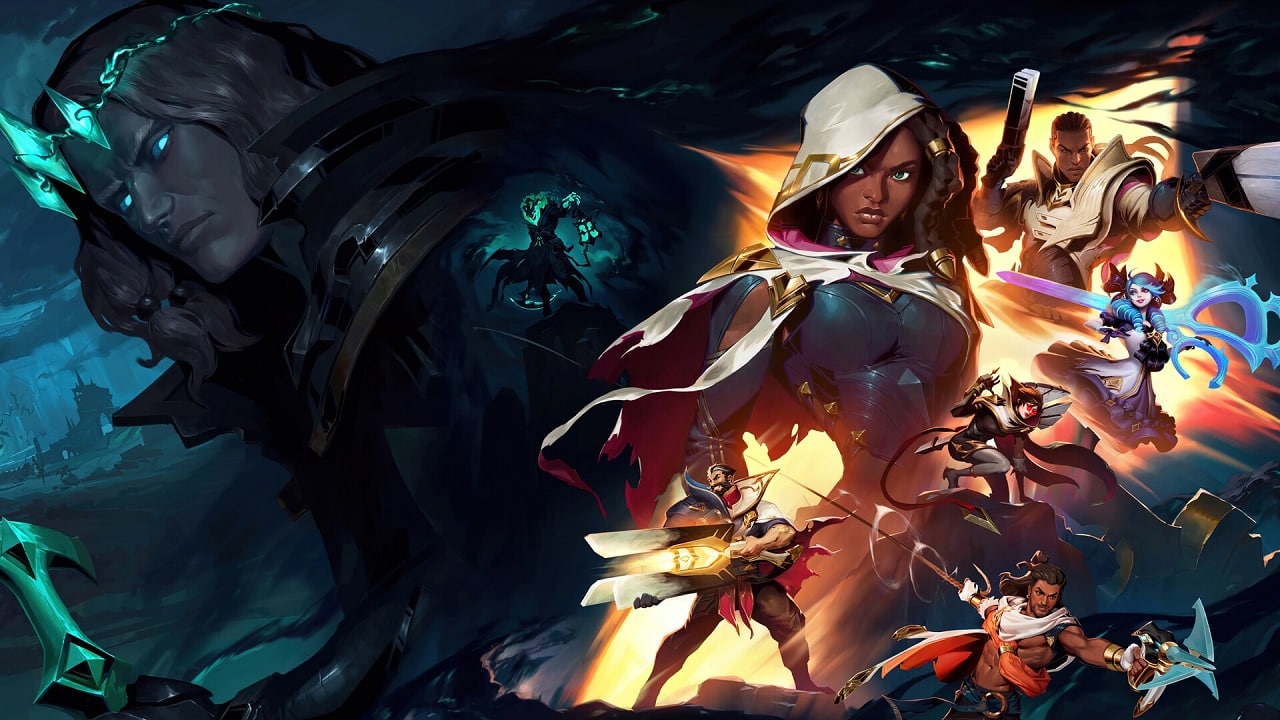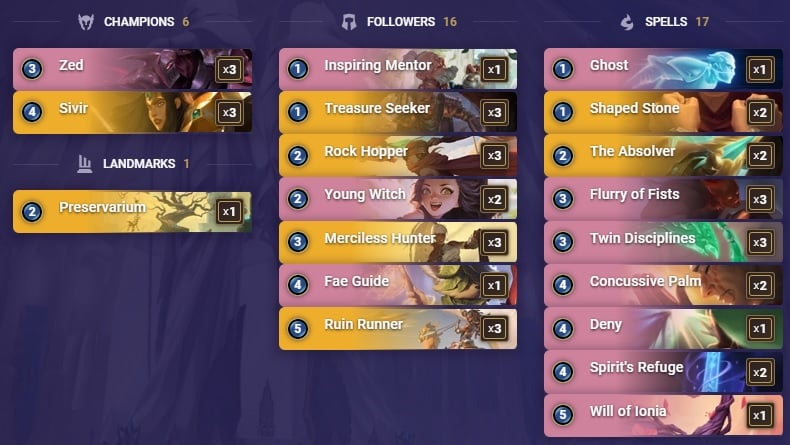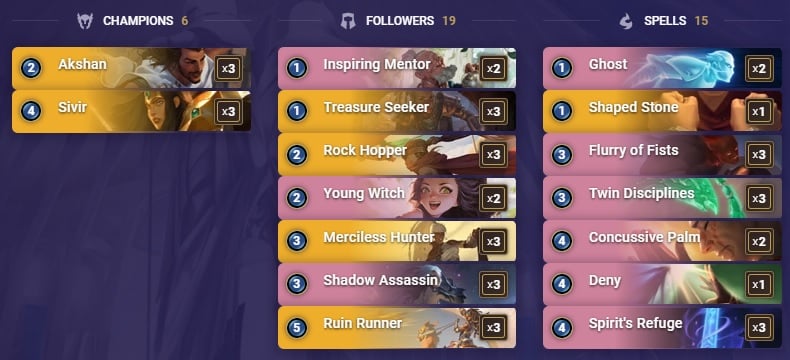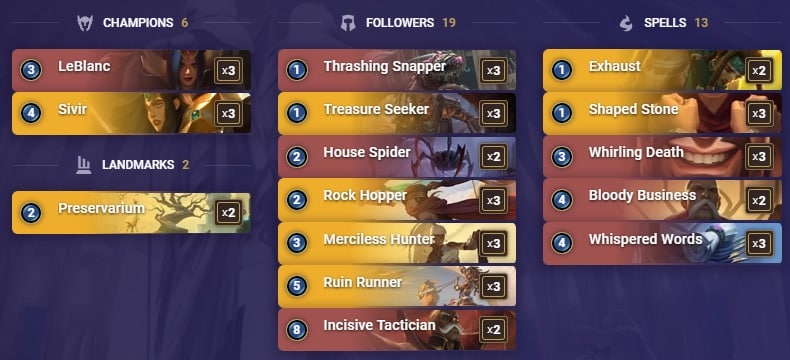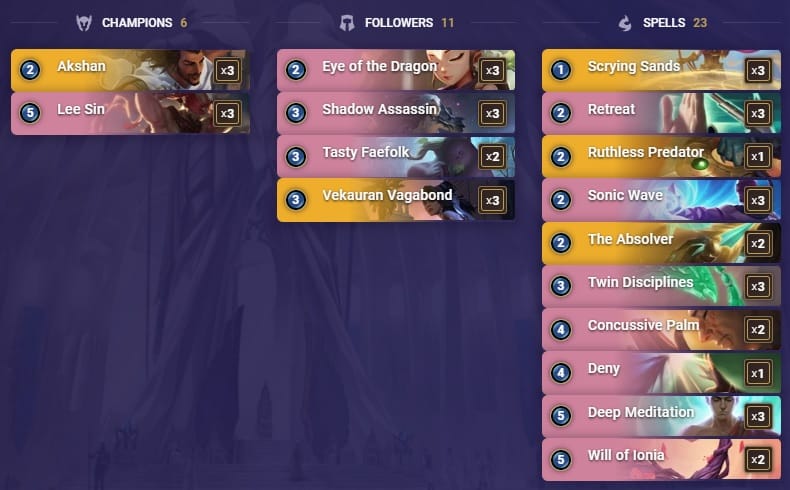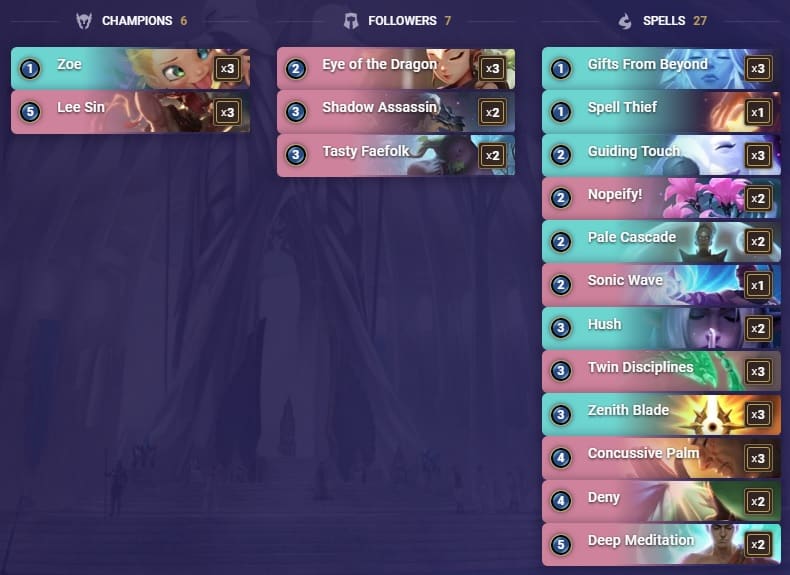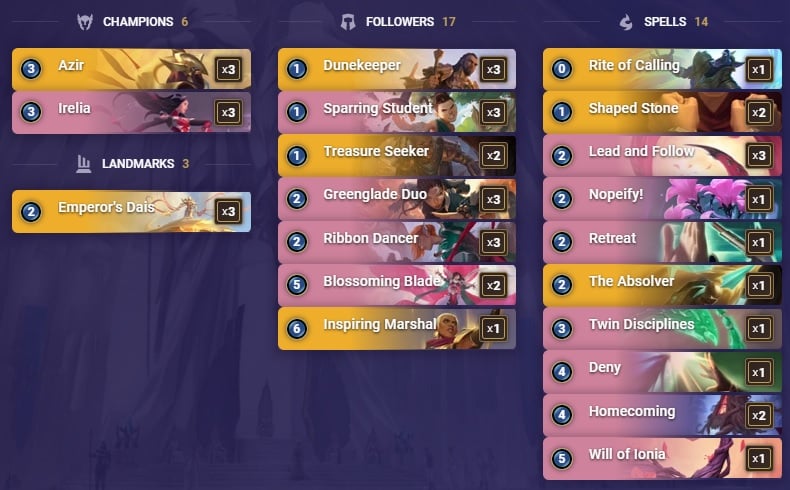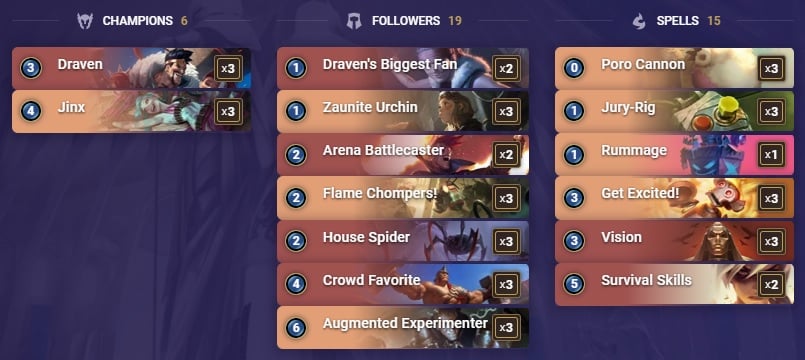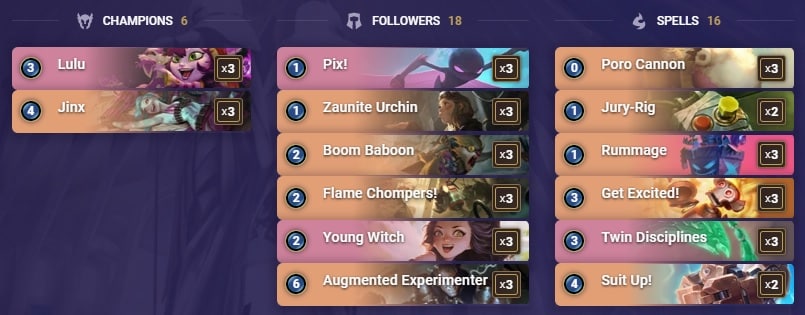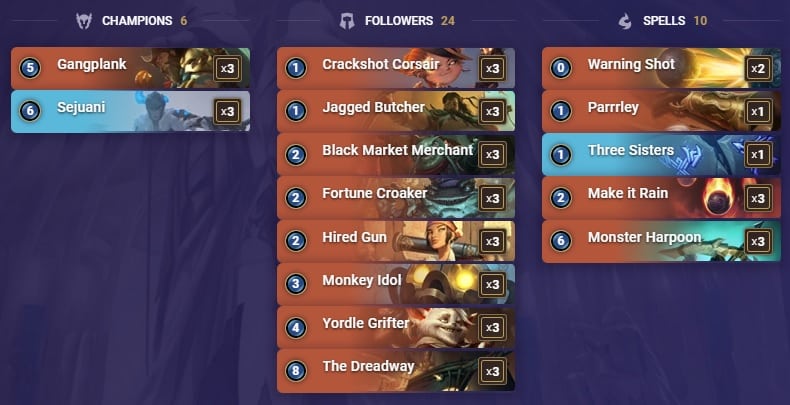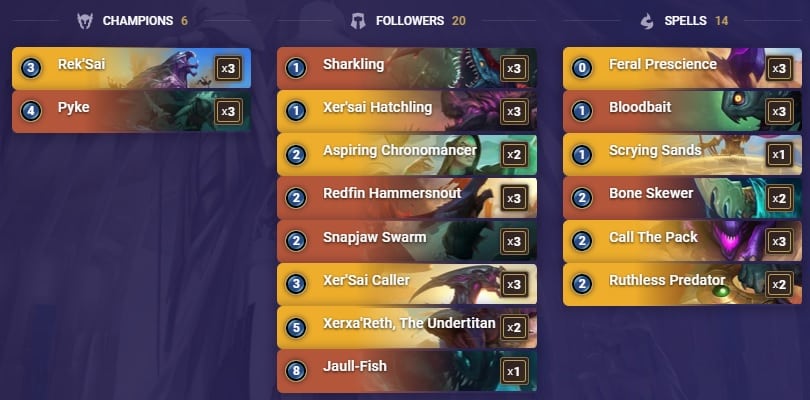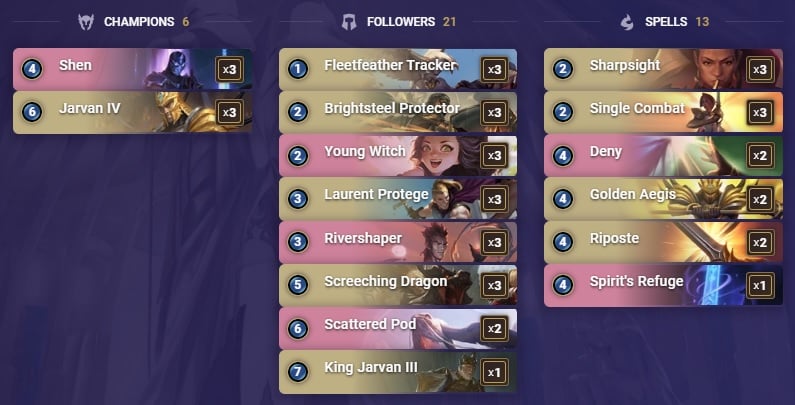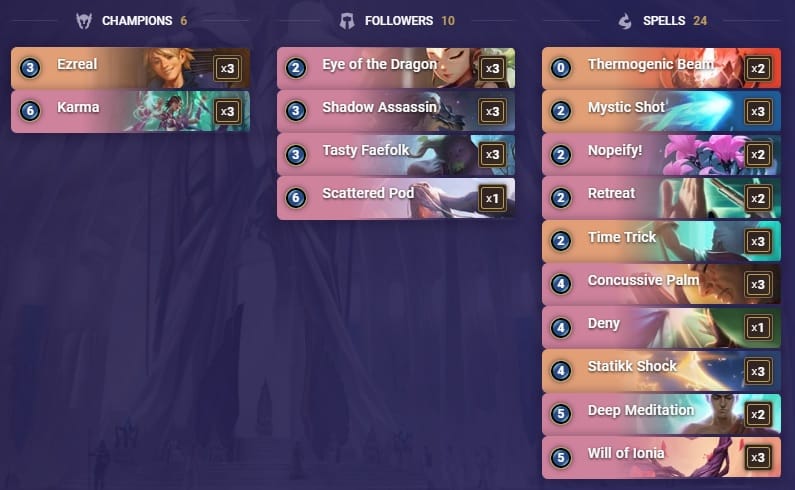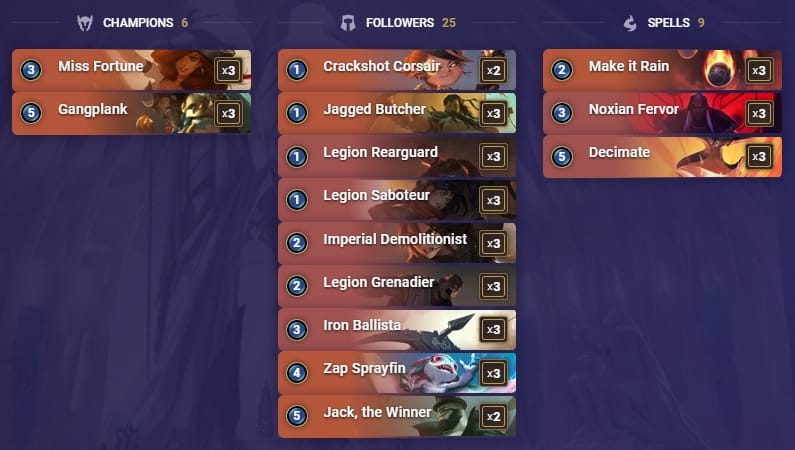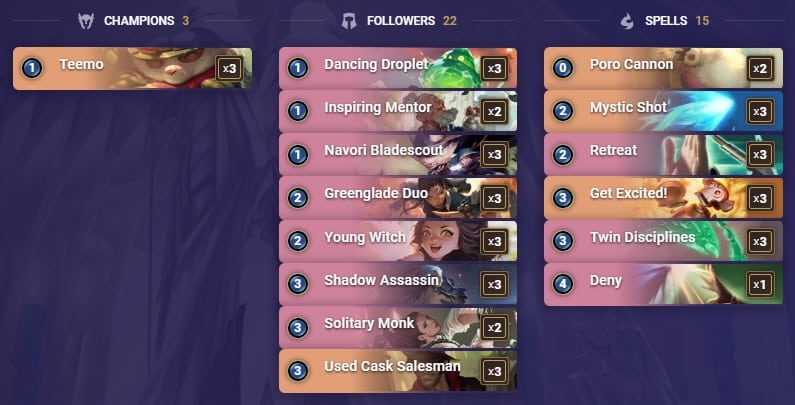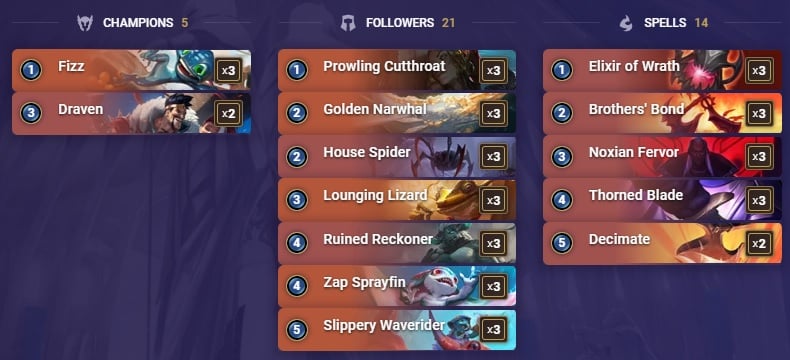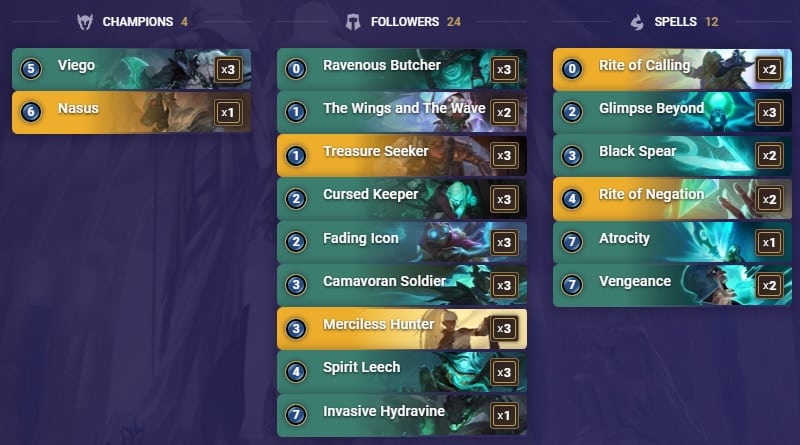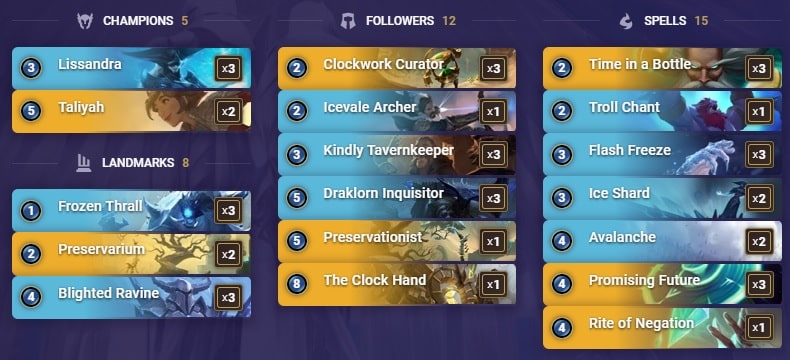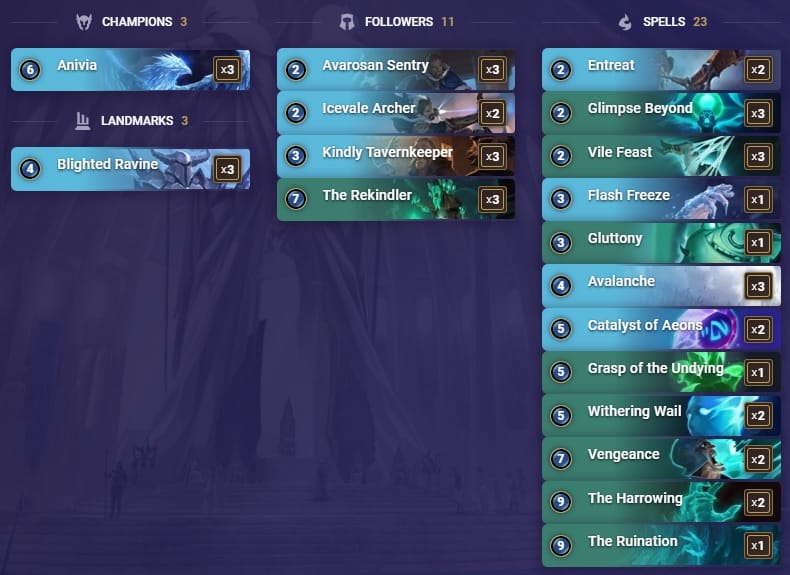Welcome to TLG’s latest meta snapshot for Legends of Runeterra, a series in which we give you our insight on the finest decks in the higher ranks of the ladder.
Every Monday, we discuss the decks that are part of the week’s meta and rate them on a scale of 1 to 5 stars. We also look at the evolution of said decks’ ratings across weeks and draw conclusions regarding the current state of the game, all of this so you can delve into your own ranked journey with a head start.
Shurima and Ionia are the dominant regions at the moment. Thankfully, it’s not solely Azir-Irelia this time - Sivir and her SpellShield, as well as Akshan and Lee Sin are also painting the top tiers gold and pink. Othal is bringing you a spotlight on why this region combination has risen to such dominance.
Since our last snapshot, we have been blessed with two expansions, so there’s a lot to break down here. Naturally, things will clarify over the next few weeks, but for the time being, we present to you our vision of how the meta landscape looks.
If you have any questions, feel free to drop by our Discord. Best of luck on your climb!
Graphics: WellMax81
Editing: Wusubi, Sebodunum
Writers: Den, Ultraman, Othal

Zed-Sivir
CMBQCAYCDEBACAQJBQCQIBYUEY3DOZYEAEAQEJIBAIBAKAIDAIFAEBAHLWFACAYBAMBAGAIEA4GQIAICAILBUMI
Rating: 4.5 stars
Difficulty: Moderate
Zed and Sivir pair up to be a frightening, albeit a fragile duo. Enabled by the combat tricks in Ionia and Shurima, they’ll rarely face an opposition able to resist their attacks and simply kill the opponent through Twin Disciplines or Shaped Stone.
Use Sivir’s level-up to give your whole board multiple keywords, the most juicy of which include Elusive, Double Attack or even Overwhelm if your version plays The Absolver. Why not gain all of them at once, for style points.
Zed is useful as a solo threat - his level-up creates a Living Shadow with his stats and keywords. While his main role is to apply early pressure, he can provide an alternate win con in his flipped form in desperate situations.
Finally, Ruin Runner is obviously terrifying, especially when given Quick Attack through the support of Young Witch. And if the opponent tries to defend against this, you can use Flurry of Fists! (Write-up by Ultraman)
Akshan-Sivir
CMBQCAYCDEBQCAQMEU4QMBAHCQTDMN3HQIAQGAICAICQCAYCBIBACAQWDIBACAICGEAQIB25
Rating: 4.5 stars
Difficulty: Moderate
Similarly to Sivir-Zed, this deck aims to exploit its strong combat tricks in order to kill whatever the opponent tries to block with. Once Sivir is leveled-up, you’ll be able to give your board a variety of keywords accompanied by SpellShield. This shouldn’t leave many other options for your opponent than to simply concede.
What differs here is that Akshan brings his amazing flexibility to the table, at the cost of the deck being less synergistic overall. Completing his first landmark will give you more consistency in your card draw, and completing the second one can give you access to many free trades and a free Ruin Runner, or more card draw with a mana cost reduction.
This represents quite a common situation with Akshan, where he doesn’t really synergize with anything, but his sheer value and ability to stay alive by himself makes up for this. He’s also a quite good enabler of The Absolver, as his level-up is easy to achieve. (Write-up by Ultraman)
LeBlanc-Sivir
CMBQCAIDBMBQIAYCAQJQMBAHCQTDMN25M4BQCAIDG4BAIAYIB4BAIBYNFUAA
Rating: 3.75 stars
Difficulty: Easy
The Reputation mechanic is finally viable! Just ignore the fact that it’s already power-crept by the Ionia version. If you enjoy the “glass cannon” archetype consisting of fragile bodies dealing big damage, you’re in for a treat.
LeBlanc makes for a nice combination with the 5 attack Incisive Tactician, allowing you to get multiple rallies. When combined with Sivir’s Quick Attack and SpellShield bonus, you should cut through most blockers. Your biggest problem is the lack of good combat tricks, making it hard to keep your followers alive, and even harder to resist any type of control.
Most things will cost an arm and a leg in terms of mana, so you’ll have to be very conservative until your opponent either runs out of steam, or you finally reach a point where your SpellShields provide sufficient protection so that you can commence the all-out destruction of the opposing Nexus! (Write-up by Ultraman)
Akshan-Lee
CMBQEAICBQ4QGBAHJ6AADAQBAUBAEAYGBAEQUBABAEBAEAICAICQCAYCBEAQIB4KAEBACAICGEAQIB2F
Rating: 4.5 stars
Difficulty: Hard
A Champion like Lee Sin is hard to balance: his identity revolves around his Dragon’s Rage combo, while his stat line has almost no relevance. This means that he either doesn’t fit into the meta, or he’s one of the best Champions. With the release of Akshan and Twin Disciplines going to 2 mana, the Blind Monk is back at the top of the food chain!
The Akshan package has a lot of high-roll potential. The addition of The Absolver allows for a burst-speed OTK by giving Lee Sin +4/+2 and Overwhelm for 4 mana. Warlord’s Palace can help you draw your crucial cards or give you the final push for damage. Warlord’s Hoard has insane value with a +2/+2 SpellShield for Champions, or the draw and cost-reduction option.
Akshan can become a huge threat to your opponent with his quick attack, and they will fear blocking him without knowing if you have a combat trick or a Retreat. But as with all high-roll decks, this version of the deck is subject to bad draws and lacks the reliability found in Targon. Your card draw is limited and The Absolver can only be tutored through Deep Meditation.
This version of the deck lacks protection, as SpellShield is only at the end of a 16-Countdown, and you cannot answer Freezes or boosts as easily as if you had access to a Hush. (Write-up by Othal)
Zoe-Lee
CIBQCAICBQBQEAQDAUDAIAYJBENTHVYBAQAQEAQJAIAQEMJZAIBQECIUAIBQSI2VAIAQEAQIAEBQSKQ
Rating: 4.5 stars
Difficulty: Hard
While the Akshan version of the deck is more popular, the good ol’ Ionia/Targon pairing of Zoe-Lee is still very powerful. In fact, it’s the most reliable build: Targon has one of the best toolboxes, and this deck gladly avails itself of this.
Supercool Starchart provides you with a lot of cheap spells to proc your Deep Meditation and Eye of the Dragon, but can also help you stall for time through the Celestial cards it creates. But wait, there’s more! Targon has the access to Hush, an instant SpellShield (Bastion) and some consistent healing and card draw with Guiding Touch.
Zenith Blade also serves as a great thinning tool for your deck; it’s a draw engine and a win condition when used on your Lee. The downside is that your game plan will be a bit predictable and slow, and the opponent can use your weaker early game to try and force you to defend instead of setting-up your own game plan.
It comes down to a matter of preference: would you rather play reliably through the power of the stars, or flash a smile, a quip and a quick OTK? After all, it will end with Lee’s kick in the Nexus, so you might as well enjoy the journey. (Write-up by Othal)
CMBQEAICAYVAGBACAUEQWAYEA4BRUMYDAEBQEBIBAQBAIAQEA43F2BABAIBAUAIDAIKAGAICAIGDCAYEA44XTCQB
Difficulty: Moderate
The bane of the past couple of months is doing well again, with decent matchups into a lot of decks. Athough both Champions now level-up slower, they still remain difficult to answer, especially with the buff to Twin Disciplines. A good starting hand is as scary as ever, but it has become easier to ignore the early aggression from Azir-Irelia, as they now receive fewer buffs and thus hit for less damage in the early game.
Still, watch out, as their damage can pile up quickly. If you’re not careful, you might get overthrown by a good turn, since the deck’s ability to attack multiple times in one turn is dangerous. Instead of aiming to control Azir-Irelia, it seems better to try to outpace it - faster decks and strategies tend to have better results, while the slower archetypes suffer.
Both Champion level-ups are impactful, so beware - one essentially makes it impossible to remove the card, while the other creates a monster with crazy attack points that buffs the whole board. (Write-up by Ultraman)
CECQCAQDBEAQGBARAECAGCQCAEBRILQEAECB6JBGGQCQCAIDGMAQCBA3AEBQGDIBAMCAKAQEAQDRAAIBAECCO
Difficulty: Easy
Ezreal-Draven is back in Tier 1, which it has been in and out of for a good while now. So, why is that the case this time? Although most of the other top tier decks aren’t particularly favorable matchups, this deck preys on the increasingly popular counters to those top tiers. These include Discard Aggro, Lulu-Jinx and Elusives.
As ever, Ezreal-Draven is a punisher, this time of those trying to counter the Ionia/Shurima decks. Thankfully, it’s stable enough to be able to defeat Lee Sin or Sivir decks (if they miss a few cards). But the greatest change comes against Azir-Irelia. As both champions are now slower to level-up, you have more time to disrupt them before this happens.
In essence, this deck is happy to face everything except for Lee Sin and Sivir. This on its own would be enough to rate it highly, but since even these aren’t terrible matchups, it deservedly takes its place in Tier 1 once more. (Write-up by Ultraman)

CEBQCAYECICACAYJCQTTOBQBAQGA2HBHFAWQEAIDAMHQEAIDA4RQCAIBAQAQ
Difficulty: Moderate
I don’t know how many snapshots I’ve written so far, but if one thing has never changed, it’s this deck. Patch after patch, new cards arriving, Draven and Jinx keep terrorizing the ladder. Whether you like it or not, they also keep being the most versatile Aggro deck out there, serving as a great power check to most decks that arrived in the latest meta.
While the decklist hasn’t changed in spite of new support for the archetype (e.g. Boom Baboon), the deck is a good example of the saying “if it ain’t broke, don’t fix it.”
In practice, the deck is still very smooth at transitioning from one win condition to another. The first step is building the board, trying to apply early pressure. This can be done to build a big Crowd Favorite, deflecting the attention from an upcoming Jinx, or to push damage for a delayed race to the Nexus.
The second step is establishing how to win from the three possible ways the deck offers. The first win con is the continuation of early board presence, which can push a ton of damage thanks to Vision or Arena Battlecaster. Draven is usually the go-to option in that case, as the Spinning Axes giving us explosive reaction potential, as well as the ability to discard units or spells with ease.
Direct damage is another win con, where Crowd Favorite and Jinx are the centerpieces. Crowd Favorite gives us the chance of not attacking early on, ignoring the board and getting that big pay-off later on, which gets damage through with Overwhelm. Jinx is the powerhouse when looking to close the deal with damage, and the early board can serve as blockers to stall while we generate Super Mega Death Rockets.
The last win con is to try and outpace the opponent thanks to drawing cards continuously. This is a route that should be taken opportunistically. For example, if you see the opponent is using a lot of resources early on to answer you, it would be reasonable to go for a flipped Jinx or an Augmented Experimenter and aim to have more cards than your opponent.
Due to this great flexibility in the core build of the deck, Discard Aggro keeps on being a contender on the ladder, and should stay that way for weeks to come. (Write-up by den)
CECQCAYECIBQGAQCBIIQMAIEAEGA2JZIFUAQIBAQAEAQEDACAEAQIHABAICAGAA
Difficulty: Moderate
Lulu-Jinx takes its place next to Discard Aggro, as both decks are similar to each other. Both use the discard package, but they do so in different ways. Lulu-Jinx aims to make value trades and take advantage of 4/4 Flame Chompers! while Discard Aggro wants to be swarming the board to create a gigantic Crowd Favorite.
Lulu’s level-up serves both as a value tool and as protection for your most fragile win conditions. Being able to give a Barrier to an ally or Vulnerable to an enemy at a 1 mana cost and at Focus speed is clearly helpful, but as it’s Fleeting, it can also be used as discard fodder for a Rummage or a Get Excited! depending on whether you need to draw or deal damage.
Augmented Experimenter will come in handy when you run out of cards or want to level-up Jinx. Elusives are here to provide direct damage, which can be elevated by Twin Disciplines. You’ll sometimes need to resort to this kind of gameplay, as you can run out of value if you don’t draw into Jinx or Augmented Experimenter.
Use Pix! and Lulu to create value while you deal heavy blows once your opponent runs out of blockers. Then, finish the job with direct damage or Jinx. (Write-up by Ultraman)
CICACAQBAIAQGBQIAECAMCQJAIDAEBILEAQSELJ2HQAQCAQGCQBACAQGCIAQIAIK
Difficulty: Moderate
Did you miss Bilgewater? With Make It Rain’s buff, the Pirates are back, and not ready to leave! GP-Sejuani is a great answer to the issues of this meta, as Freeze effects stop most of the synergies in both Lee Sin and Sivir decks. As such, Sejuani’s level-up is terrifying for most of the top tier decks.
For handling other decks, the classic tenets of having a decent starting hand and flipping your champions apply. You want to level-up GP and Sejuani as fast as possible in order to pressure your opponent with AoEs and Overwhelm on both cards.
You’ll need the help of many Powder Monkeys and Warning Shos, activating your Plunder units and the level-up conditions of your Champions simultaneously. Try eroding the opposing Nexus with your followers, but keep in mind that your win condition is entirely tied to drawing your Champions, so don’t hesitate to keep one occasionally in your opening hand if your early curve is good enough already! (Write-up by Ultraman)
CMBAKBAGAEBQIBIPAUCAOE2EJJIFGAQBAQDAEAYEA4AUCRICAECAMBYBAQDU6
Difficulty: Moderate
It’s summertime. Beaches are full, comprising a vast amount of sand and saltwater, where the common people might come to forget the vicissitudes of life, if only for a while. They play around, they laugh, they rest. But not you. You wait, you plan... you lurk.
Pyke and Rek’Sai are here with you, hand in hand, waiting. You know the right moment is coming. You predicted it, listening to your Feral Prescience. You play them, a constant threat. But just one strike with the Bone Skewer and they’re back at the top of the deck, patiently lurking again.
You cover Rek’Sai in Bloodbait, making sure to attack relentlessly, boosting her packmates even during your opponent’s turn. The ground shakes. She’s here, ready to feed on the weak. You attack, and her cry bolsters your lines.
What can puny mortals hope to do against your array of 10/1 Fearsome 1-cost Xer’sai Hatchlings? Your opponent can fight, they can struggle, but what can they do to stop Pyke and Death From Below?
And when they watch, bloody and battered but still breathing, proud to have dealt with your first wave of creatures, it will come, drawn by blood in the water. The Snapjaw Swarm, and its relentless pressure. During your turn, during the opponent’s, always here to catch your prey off-guard. (Write-up by Othal)
CECQCAYCBIAQIAAIAIAQEIBLAIBQABQOAQAQACILDIOQIAIBAASQCAICGEAQIAACAECAEFACAEAQEJIBAQAAU
Difficulty: Moderate
With some new additions, the classic Demacia/Ionia combo is back at it once again, taking advantage of a good matchup into other Ionian archetypes, such as Lee Sin decks and Sivir decks, while holding its ground against most other decks in the meta. It’s mostly a question of set-up, as you need to hold the board for some rounds to start getting good value trades.
The deck is terrifying once it’s ahead, as most of its combat tricks will stop the opponent from removing your cards, while you increase the pressure every turn! But watch out, as once you’re behind, it’s difficult to come back.
Be ready to sacrifice your Nexus health until you’re back in a situation where you can develop those sweet barriers and slowly regain board control. (Write-up by Ultraman)
CECQCBAEA4AQGAQJAIBAEAYFAMAQIHZEGQBQCAQCFE4QGAIBAQNQCAYCCQBAEAQJBIBACAICGEAQIAQU
Difficulty: Hard
Upon hearing the news of Karma going down to 5 mana, many players expressed their concern about the fact that Karma is a damn good card in the right situation. The ladder might not be the best environment to create that situation currently, as the many Shurima/Ionia pairings make it difficult for a spell-based deck to be truly competitive.
Ezreal-Karma can be considered a work in progress at this point. There are a lot of builds available online and even top ladder players are still trying to find that perfect balance in the various important aspects of the deck. These revolve around whether it’s drawing enough cards, whether it has sufficient spells to interact with the opponent, or having enough ways to protect our most important units.
For now, the deck should focus on board interaction and try to slow down the opponent with Concussive Palm or Will of Ionia. But it also needs to be drawing enough to be stable over a long period of time, as these control-oriented decks can be heavily punished by a bad hand early in the game.
The main thing to address in this meta is to establish how much healing the deck actually needs. The options are limited, as it’s either Tasty Faefolk or Health Potion. Both are good options for different reasons. The power of the deck is undeniable though, and compared to other struggling decks, Ezreal-Karma has the most potential.
If other decks emerge down the line, and maybe some slower ones in that group, Ezreal-Karma sn’t far from being a great pick to climb the ladder or get some tournament wins. (Write-up by den)
CIBQGAQDAMCAKBABAMBAYJJIAUBAMFRAEYWTUAQBAIDDYAIDAYDAA
Difficulty: Easy
Stand up on the prow, steady course to the haven, bring sugar, tea and rum, for today we’re Pirates! One of the most prevalent archetypes at the start of every season, Pirates have the advantage of offering fast and straightforward gameplay.
Swarming the board with low-cost units, Pirates put a lot of early pressure on the opponent. Attack after attack, your victim will soon be forced to try to survive and outplay you while you simply play on curve. Miss Fortune is an incredible Champion to have on the board, as her skill will give you positive trades against low-cost units like Dragonlings, all the while burning the opposing Nexus without ever needing to put herself in harm’s way.
You should not be afraid to call all hands on deck and charge with every one of your units, though, as your main goal will be to soften the enemy for a last push with direct damage. Keep in mind that this deck provides you with a lot of Burn, meaning you can also inflict damage on defensive turns via Imperial Demolitionist or Legion Saboteur.
If the fight’s still on and the enemy board is too big for you to deal with, the addition of Jack, the Winner allows you to put your now-defunct units to good use through Sleep with the Fishes. With Decimate and Noxian Fervor, your opponent should quickly be walking the plank and feeding the Sharklings below. (Write-up by Othal)
CECQCBACB4CACAQGBQITSBABAQEBCJZUAEBAECQBAMBAUAQBAMCBEAQBAINCMAIBAEBDC
Difficulty: Easy
Given the amount of Ionia/Shurima decks in Tier 1, it’s no surprise that Elusives (and Teemo) are re-emerging from hibernation. Apart from the decent region combination, Elusives are well-placed to make hay in the current meta, mostly due to a general lack of reliable control decks, AoE and removals at the moment.
Ezreal-Draven or Ezreal-Karma are the last remaining threats for your Elusive game plan, as they’e still able to kill most of your followers, preventing you from bursting fast enough to finish the game. Against them, playing Twin Disciplines and crossing your fingers is probably your best bet.
Against Lee Sin, Sivir, or Azir-Irelia, you’ll be at a huge advantage, as you’re much faster and benefit from their lack of removal. Don’t forget to be greedy with this deck, as playing Elusives requires that mentality to close the game! (Write-up by Ultraman)
CICQCAQDAMAQGBQCAICAGCIWAMAQGGI3G4CQEBQNEQTC4OIBAIAQGAQUAA
Difficulty: Easy
What a strange blast from the past! Elusives have made their return, with a Noxus/Bilgewater combination, making use of the attack buffs and of Fizz’s ability to keep stayin’ alive. Use Ruined Reckoner to rally your best card on the board and deal massive blows to the opposing Nexus.
If your Elusiveness isn’t enough to surprise the opponent, regular aggression is also a possibility, as curving out and attacking your opponent until they stop moving is sufficient in some cases. Use and abuse the lack of control in the meta, while hoping not to face the only control player on the entire ladder. (Write-up by Ultraman)

CMBQEBAHGZTQGAIFBMYDCBAEAUBRANRXAMAQIBIEAIAQKAJCAICAOO3ZAMAQCBIZAECAOLYBAQCTK
Difficulty: Moderate
Sometimes, there are decks that seem to perform well for some and badly for others, and we can’t really put our finger on why. That is exactly what’s happening with Viego currently, as Alanzq is routinely piloting the deck in the Top 10 of ladder, while most people can’t manage a 50% win rate with the deck.
Because we all know the qualities of Alan as a ladder player, we have to come to sad conclusion that the deck may just not be as good as we would want it to be. The main reason for this is the amount of time it gives the opponent before punishing them. It’s also important to note that for now, there isn’t really a clear-cut best list with Viego. At the moment, he’s split between solo appearances, with Thresh and with Nasus.
In its core, the deck alternates from being a Midrange, board-based deck that looks like it will never run of steam, to a control, backrow deck that’s totally okay taking the raw value of summoning Encroaching Mist turn after turn, and threatening lethal through Atrocity and Viego’s level-up.
This dual threat ability is great when you’re the one in charge and direct the game as you please. It can be a bit different when you start falling behind and are no longer in the driving seat. The deck feels a lot worse when you start needing to take risks to keep your Viego alive or need to defend against Elusives or direct damage based decks.
Basically, Viego could be called the king of the board. But today’s game isn’t won solely on the board anymore, and decks like Lee Sin or Sivir-Zed are capable of finding a way through even the biggest units in the late game. It can be the same for Aggro decks now too, since the early game has been slowed down a bit with the absence of Baccai Reaper to pressure the opponent. Instead, the deck uses small units to set-up for Viego’s arrival, which ideally will lead to an insane mid game.
Don’t get it wrong, Treasure Seeker, Warden’s Prey and Cursed Keeper are all strong. But they can rarely match the early game explosiveness of Akshan or Draven, creating an awkward situation to transfer towards Viego afterwards. (Write-up by den)
CEBQEAIBAEZAGBAHD4WEEBAEAEAQKBQOAMAQIAIJAEAQCFACAQDQ2SIDAEAQCCYBAMAQEAYEA4RDW2A
Difficulty: Hard
Seen as the go-to Freljord deck after the fall of TLC, Thralls haven’t lived up to the expectations. Although most of its mechanics are looking good in the current meta (e.g. Freeze being very useful against Lee Sin), something is just not clicking for the deck.
The main problem is the presence of Sivir and Azir-Irelia, as both artchetypes present too much of a threat for Thralls to handle. Another problem is the amount of small but pressing threats currently, which are forcing the deck to use AoEs when it would rather not have to.
Akshan is a great example of this, as he cannot be left alone on the board despite being a 2/2, as leaving him alone without an Avalanche or Blighted Ravine would allow him to quickly advance your opponent’s win condition.
For those reasons, Thralls seems to have a difficult time defending and should evolve into a turbo Thrall iteration if they want to keep up. This would be a risky approach, but a necessary one, as it would tell us if the deck has a chance at being relevant in the upcoming weeks. This take should at least help Thralls be too much to handle for the other slow decks, such as the PnZ builds.
Another thing Thralls might be looking for is when Viego’s build will be finalized. The deck was a soft counter to Thresh-Nasus in the previous meta, so it could look to prey on SI decks.
It may be that all the shiny new things we have received in the last month has made people lose interest in the deck, so once things settle down a bit, we might see Thralls in ascendance once more. (Write-up by den)
CEBQCBABBYBQCBIUFAYQIAIBAMKBQMQCAMAQCCYMDUBQCBIBAMOQGAIBAEAQCAYFCIBACBIPGY
Difficulty: Moderate
Rising once again from its frozen ashes, Anivia apparently would like to have a word with the current meta. Although the deck had a big surge in play on the first day of the new Ruination event, it quietened down fairly fast. This might be because SI and Freljord look like they will never truly go away as a successful pairing.
Just like its old self, the deck relies on destroying tempo, slowly taking over the board with Anivia coming back time after time, and locking down the game as time progresses. This is something that feels easier to do now that TLC isn’t around to punish any kind of a slow strategy.
To be honest, the deck still feels like it’s too slow and too grindy in its gameplan to be reliable and trusted on a big sample size. Explosive decks will always have a chance to burst through you if you miss that must-have card at the right time, and the high popularity of Sivir and Ionia are currently making Anivia’s life very difficult.
The deck can still navigate its way through the more grindy matchups like Viego. So, if you’re seeing a lot of the Ruined King at your rank, you might want to give a chance to the Frozen Bird.
For now, I would put my money on a temporary presence for Anivia. It’s hard to imagine the making the cut in a BO3 tourney format given the current power level of other decks. But we’re talking of a deck that has routinely been a surprise and is at its best when least expected, so maybe it could get some precious wins in the right line-up once the meta settles and we know exactly what are the decks to beat. (Write-up by den)

Oh, how the crowd sang when Azir-Irelia died. People danced, named their children Rubin, parades celebrating the balance team started spontaneously in every corner of the world. There was much rejoicing. But in the shadows, while everyone was happy and joyful, their heir swore to return and avenge them. The world would hear from Ionia/Shurima once more, and the world would weep! (Write-up by Othal)
Sivir-Zed was the first herald of the return. Akshan was the second herald, and the innocents trembled when he joined forces with Lee and Sivir. And finally, they returned. Azir-Irelia, hand in hand, ready to take back the crown that was rightfully theirs.
While other region pairings have good synergy and are rarely seen one without the other (like Freljord/SI or Bilgewater/Noxus), Ionia/Shurima looks to be the dominating region pairing on the ladder currently. Ironic, when you remember they were both considered support regions a few patches ago. But that’s exactly the reason for their success.
Ionia and Shurima have many combat tools that put Demacia to shame: Twin Disciplines, Shaped Stone and The Absolver are all efficient burst-speed tricks that force opponents to stay on their toes, as just 1 spell-mana could suddenly mean having to deal with 3 more damage.
But they don’t have to choose between offense and defense, thanks to Ionia. Cheap cards like Retreat or Lead and Follow can protect key units while putting down more board pressure. Eye of the Dragon can help soak a lot of early game damage and opposing pressure. And the more expensive cards like Concussive Palm and Will of Ionia can reset the opponent’s game plan.
What’s more, Ionia/Shurima have access to 2 of the best disruption tools in the game: Rite of Negation and Deny. So while this pairing can apply some pressure and play to its game plan, they also have all the necessary tools to deny any opportunity for their opponents to do the same.
The addition of Akshan and the buff to Sivir allowed Shurima to better express themselves as a full-blown region, most notably by giving access to burst-speed Overwhelm (The Absolver) and helping them dominate the board - as was originally intended.
Their reliable access to SpellShield via Warlord’s Hoard, a flipped Sivir or a Ruin Runner also means that their opponents must use more resources to defend themselves, delaying their win con once again.
While this may seem a dire outlook, it’s very interesting to note the diversity of gameplay these archetypes offer. Sivir-Zed plays more like an Aggro deck, Azir-Irelia is a combo deck and Akshan-Lee is more of an OTK deck. Everyone can find something they like in this pairing, and as a player I find this super enjoyable.
Before lamenting about the state of the meta, we should remember one thing: even if the pairings are the same, diversity is still the name of the game. And in Gauntlet or Seasonal, you will only be able to bring one of them anyway, so choose wisely!

